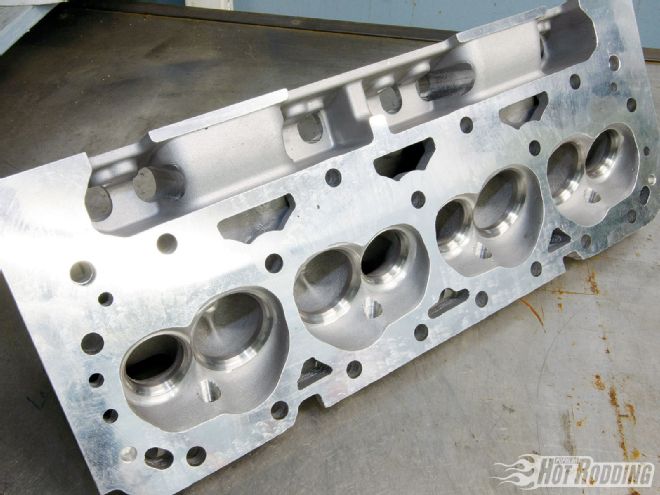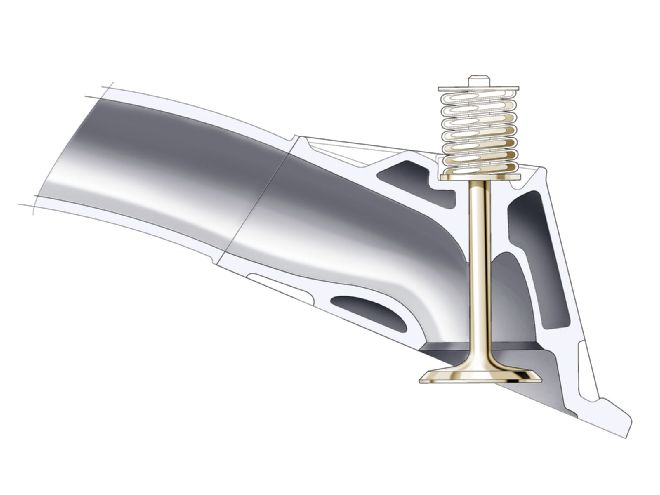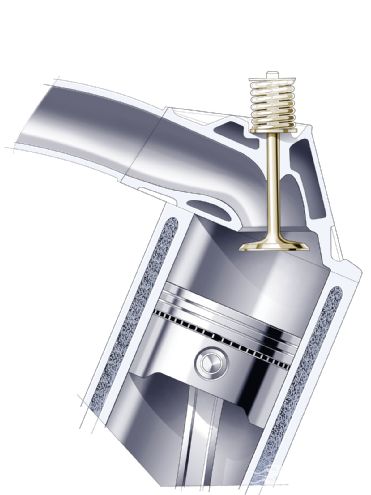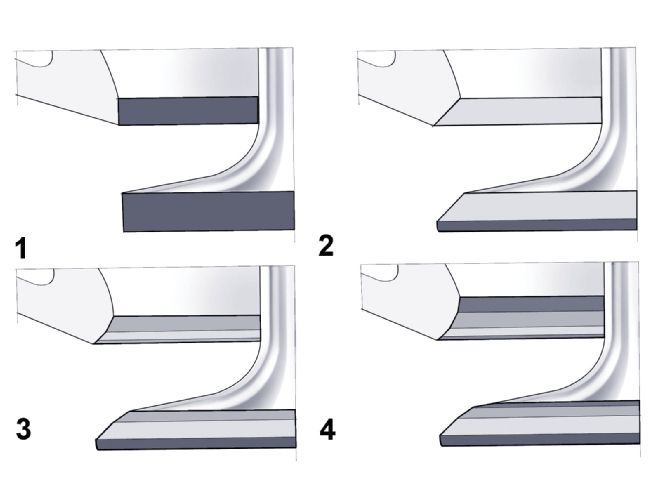
Porting gets all the attention when it comes to preparing cylinder heads to rocket more air fuel into the chamber. Granted, a well planned and executed port job can turn stifling heads into free-flowing ones that allow an engine to be a more efficient air pump, but there's one small, but oh-so important detail that never gets the credit it should: the valve job.
 This cutaway illustrates the short versus long side of the valve. Air behaves as a fluid when flowing, so imagine a garden hose blowing water down the port. The water would tend to rush toward the far side of the valve and only begrudgingly exit through the short side once the far side is at capacity.
This cutaway illustrates the short versus long side of the valve. Air behaves as a fluid when flowing, so imagine a garden hose blowing water down the port. The water would tend to rush toward the far side of the valve and only begrudgingly exit through the short side once the far side is at capacity.
No matter how good or bad a cylinder head's runners flow, the biggest impediment is always the valve. All that air rushing in from the intake has to slip through a tiny curtain of space that's equivalent to the area between the bottom of the valve at peak lift and the valve seat. That's why camshaft lift and duration are the two factors that can most alter an engine's performance and operating range; the larger the curtain and the longer it stays open, the more air and fuel can flow into the combustion chamber.
But there's more to it than that. Air hates to change direction, especially fast-moving air, and forcing it to do so will decrease airflow. To help ease the transition, valves and valve seats have angles cut into them to make the air curve. This is especially important on what's known as the "short side" of the valve, which is the side of the valve seat that rolls from the floor of the port. Since air abhors a curve, it wants to take the straighter path toward the far side of the valve. Consequently, that side of the valve is generally jam-packed with all the air it can handle and then some. That's where a good valve job can show the largest gains-by convincing more air to take the side less traveled and mitigating the bottleneck.
Troy Bowen at Ford Performance Solutions (FPS) in Anaheim, California, says a proper performance valve job is critical-even more so than porting in some ways-and he volunteered to show us how a basic performance valve job is performed on FPS's own Avenger aluminum cylinder heads. We may be starting with a high-performance head, but the concepts will work for any other aftermarket or OEM head as well.

There's one other massive benefit to a performance valve job. Porting is time intensive and therefore expensive, but a good performance valve job can get you nearly 50 percent of the way there for a fraction of the cost of a full porting job. Whereas fully porting a set of heads can run from $500-$1,000 or more, a performance valve job is a bargain at less than half the price. FPS charges $179 for their own heads, $225 for most inline valve heads, and $260 for canted-valve heads.
How Many Angles?
The rationale out there is that if angles work to smooth out the flow, then cutting more should be even better. It sounds good in theory, but in reality there is a point of diminishing returns-especially on mild performance engines. Troy Bowen prefers four cuts on the seat of varying degrees, depending on the head for most combinations. As for more angles affecting longevity, Bowen says it's a myth. As long as the valve seat is the appropriate width of around .045-.060, longevity shouldn't be an issue.
 Granted, unless you're working on prewar antiques, you're unlikely to ever see a transition as stark as image 1, but it does create an excellent visual aid for how flow increases with less dramatic valve seat angles. Image 2 is similar to many early heads with a single 45-degree valve seat, image 3 is a three-angle cut, and image 4 represents a four-angle similar to what FPS uses with 30-, 45-, 60-, and 75-degree cuts from top to bottom.
Granted, unless you're working on prewar antiques, you're unlikely to ever see a transition as stark as image 1, but it does create an excellent visual aid for how flow increases with less dramatic valve seat angles. Image 2 is similar to many early heads with a single 45-degree valve seat, image 3 is a three-angle cut, and image 4 represents a four-angle similar to what FPS uses with 30-, 45-, 60-, and 75-degree cuts from top to bottom.
Angles vs. Radius
Why does the exhaust get a radius rather than angle cuts on the seat? Troy Bowen says it's due to the sheer speed and pressure of the exiting exhaust gas. "We use a flow bench to measure the air going into and out of the head at 28 inches of water with the velocity at approximately 100 mph. These machines are trying to simulate a running engine, but this is not the environment that a head really functions in. After the explosion in the combustion chamber, extreme pressure is created and when the exhaust valve opens, the air is pushed out at speeds well above what the bench can create, making it impossible to simulate on a flow bench. There are guys working on computer models to find out how to optimize the exhaust." Basically, angles don't really help in this case since the gas is forcefully flowing and a well-formed radius is employed to simply funnel gas out of the chamber.